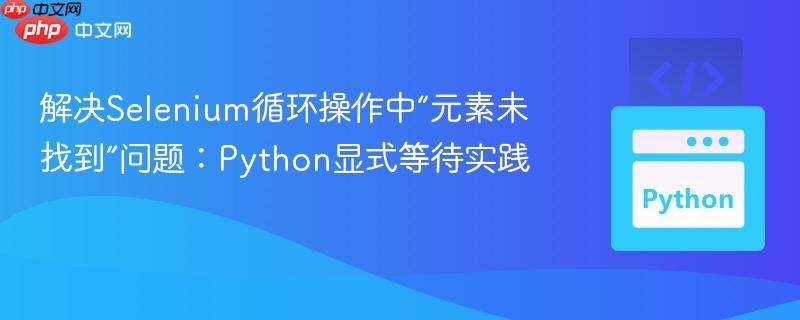
本文深入探讨了selenium自动化测试中循环操作时“元素未找到”的常见问题,特别是在页面动态加载或重复导航场景下。通过对比隐式等待和显式等待的机制,文章详细阐述了如何利用python的`webdriverwait`和`expected_conditions`来精准地等待特定元素的出现或可交互状态,从而提升自动化脚本的稳定性和健壮性,确保在复杂的业务流程中元素能够被可靠地定位和操作。
在Selenium自动化测试中,页面元素的加载往往需要时间,这可能导致脚本在尝试操作元素时,该元素尚未出现在DOM中或尚未达到可交互状态,从而引发“元素未找到”的错误。为了解决这一问题,Selenium提供了多种等待机制:
隐式等待 (Implicit Wait): 隐式等待是全局设置,一旦设置,它将应用于WebDriver实例的整个生命周期。当尝试查找一个元素时,如果该元素未立即出现,WebDriver会在指定的超时时间内不断地重试查找,直到元素出现或超时。例如,driver.implicitly_wait(7)。 局限性: 隐式等待是“all or nothing”的,它会等待所有元素,并且如果元素在超时前出现,它不会立即继续,而是会等待直到找到或超时。在动态页面或需要等待特定条件(如元素可点击)的场景下,隐式等待可能不够灵活,甚至可能与显式等待产生冲突。
显式等待 (Explicit Wait): 显式等待允许我们为特定的元素设置特定的等待条件和超时时间。它会等待直到某个条件满足或超时,如果条件在超时前满足,脚本会立即继续执行。这是处理动态页面和复杂交互场景的首选方法。
在用户提供的代码中,核心问题出现在一个循环中,当没有可用的预约槽时,脚本会返回主页并重新开始预约流程。在第一次执行时,元素可以被正常找到,但在后续循环中,尝试点击#mat-select-value-1时却报错:Message: Element {#mat-select-value-1} was not present after 7 seconds!。
这个错误通常表明以下几点:
例如,在select_first_category函数中:
立即学习“Python免费学习笔记(深入)”;
def select_first_category(sb):
sleep(1) # 硬等待,不推荐
sb.highlight(".mt-15")
sb.click('#mat-select-value-1') # 问题所在:直接点击,没有等待元素就绪
sb.click('span:contains("Application Centre")')
select_second_category(sb)这里的sb.click('#mat-select-value-1')是直接尝试点击元素,如果元素在sleep(1)之后、点击之前未能完全加载或变得可点击,就会失败。
为了解决上述问题,我们应该使用显式等待来确保元素在执行操作之前满足特定的条件。WebDriverWait结合expected_conditions(简称EC)是实现显式等待的关键。
首先,需要导入必要的模块:
from selenium.webdriver.support.ui import WebDriverWait from selenium.webdriver.support import expected_conditions as EC from selenium.webdriver.common.by import By
然后,我们可以将select_first_category函数中的直接点击替换为显式等待:
def select_first_category(sb):
# 显式等待,等待 #mat-select-value-1 元素变得可点击,最长等待10秒
# 注意:sb在这里扮演了driver的角色
try:
# 等待下拉菜单的触发元素出现并可点击
element = WebDriverWait(sb, 10).until(
EC.element_to_be_clickable((By.ID, "mat-select-value-1"))
)
element.click() # 点击触发下拉菜单
print("Dropdown trigger #mat-select-value-1 clicked >>>>> Success")
# 等待下拉菜单中的具体选项出现并可点击
# 这里假设 "Application Centre" 是一个可见的文本,并且在span标签内
# 可以根据实际情况调整定位策略,例如使用XPath或CSS选择器
option_locator = (By.XPATH, '//span[contains(text(), "Application Centre")]')
option_element = WebDriverWait(sb, 10).until(
EC.element_to_be_clickable(option_locator)
)
option_element.click()
print("Option 'Application Centre' selected >>>>> Success")
except TimeoutException:
print("Timeout: Element #mat-select-value-1 or 'Application Centre' option not found or not clickable.")
# 可以选择抛出异常、重试或执行其他错误处理逻辑
raise # 重新抛出异常,让上层捕获处理
select_second_category(sb)代码解析:
expected_conditions模块提供了多种预定义的条件,用于满足不同的等待需求:
选择合适的预期条件至关重要。对于点击操作,element_to_be_clickable通常是最佳选择。
为了使代码更具可读性和可维护性,可以考虑将显式等待封装成一个辅助函数,或者在sb对象中添加一个方法(如果sb是自定义的WebDriver封装)。
示例:自定义等待点击方法
# 假设 sb 对象有一个内部的 driver 实例,或者 sb 本身就是 driver
# 如果 sb 是 SeleniumBase 实例,它可能已经提供了类似的等待方法,例如 sb.wait_for_element_and_click()
# 以下是一个通用封装示例,假设 sb 行为类似于 driver
def wait_and_click(sb_driver, locator_type, locator_value, timeout=10):
try:
element = WebDriverWait(sb_driver, timeout).until(
EC.element_to_be_clickable((locator_type, locator_value))
)
element.click()
print(f"Element {locator_value} clicked successfully.")
return True
except TimeoutException:
print(f"Timeout: Element {locator_value} not found or not clickable after {timeout} seconds.")
return False
except Exception as e:
print(f"Error clicking {locator_value}: {e}")
return False
# 在 select_first_category 中使用
def select_first_category(sb):
if not wait_and_click(sb, By.ID, "mat-select-value-1"):
# 处理点击失败的情况,例如重试、记录日志或退出
raise Exception("Failed to click #mat-select-value-1")
# 假设 'span:contains("Application Centre")' 是一个 CSS 选择器
# 如果是 XPath,则 By.XPATH
if not wait_and_click(sb, By.XPATH, '//span[contains(text(), "Application Centre")]'):
raise Exception("Failed to select 'Application Centre'")
select_second_category(sb)
# 其他函数也应类似地替换直接点击为等待点击
def select_second_category(sb):
# 假设 #mat-select-value-5 是 ID
if not wait_and_click(sb, By.ID, '#mat-select-value-5'):
raise Exception("Failed to click #mat-select-value-5")
# 假设 '//*[@id="mat-option-2"]/span' 是 XPath
if not wait_and_click(sb, By.XPATH, '//*[@id="mat-option-2"]/span'):
raise Exception("Failed to select option 2")
select_last_category(sb)在Selenium自动化测试中,尤其是在涉及循环操作、动态内容加载或页面导航的复杂场景下,“元素未找到”是一个常见的挑战。通过理解隐式等待的局限性并充分利用Python WebDriverWait和expected_conditions提供的显式等待机制,我们可以编写出更加健壮、高效且可靠的自动化脚本。正确地运用显式等待,能够确保在元素真正准备好被操作时才执行相应的交互,从而显著提升自动化测试的成功率和稳定性。
以上就是解决Selenium循环操作中“元素未找到”问题:Python显式等待实践的详细内容,更多请关注php中文网其它相关文章!

每个人都需要一台速度更快、更稳定的 PC。随着时间的推移,垃圾文件、旧注册表数据和不必要的后台进程会占用资源并降低性能。幸运的是,许多工具可以让 Windows 保持平稳运行。

Copyright 2014-2025 https://www.php.cn/ All Rights Reserved | php.cn | 湘ICP备2023035733号